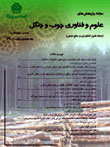The effect of physiographic factors on the leaf area index in broadleaf forests of Golestan province
Leaf area index (LAI) is one of the most important structural characteristics of forest ecosystems, which has a great impact on changes in energy, weather, atmospheric and gas functional models. This index provides managers and planners with a lot of information related to the amount of photosynthesis, evaporation and transpiration and fertility of different habitats. Physiographic factors also (elevation above sea level, aspect and slope) play an important role in the global LAI. In this research, the changes of the LAI in different classes of elevation, aspect and slope are compared and evaluated.
n this study, 230 square-shaped sample plots with an area of 1000 square meters were used to collect the ground information of the leaf surface index using a systematic sampling method with a sampling grid of 100 x 100 meters in five sites (Kordkoy, Shast Kalateh, Zarrin Gol, Sokhdari and Loveh). In the center of each plot, a leaf harvesting trap with dimensions of 60 x 60 cm was used to measure the LAI. First, height maps from elevation, aspect and slope were also prepared and their values were extracted. Then the LAI was compared and analyzed in different classes of elevation, aspect and slope using Duncan's and independent t tests.
The results of LAI showed that the elevation of LAI in Kordkoy vegetation was measured with 8.91 and the lowest level of LAI was measured with 5.10 in Zarrin Gol vegetation. The results of analysis of variance showed that there is a significant difference between the LAI in different classes of elevation above sea level in the entire study area. And with the increase in elevation above sea level to about 1300 meters, the LAI increases and after that, the LAI has little changes. The significant results of Duncan's test and independent t-test showed that there is no significant difference between the LAI of each site in different classes of elevation above sea level, aspect and slope, except for Kurdkoy site.
In general, in this study, the elevation compared to the slope and aspect was raised as a very important factor for investigating LAI. Investigating the effect of physiographic factors such as elevation above sea level, slope and aspect on the LAI and monitoring its changes in order to know the formulation of appropriate policies to reduce the effects of climate change and global warming and in sustainable management is of great importance.
-
Investigating the effect of the processing method and accurate ground control points on the quality of the digital surface model obtained from UAV Images in forest areas
Hava Hasanvand, Hassan Akbari, Shaban Shataee *, Majid Lotfalian, Alireza Hoseinpour
Journal of of Geographical Data (SEPEHR), -
Estimation of stored water volume in reservoir dams using satellite images and multi-variable linear regression model
Hamed Feizabady, Abdolreza Zahiri *,
Water and Soil Conservation, -
The Effects of Changes in the Forest Structure’s Quantitative Traits on the Leaf Area Index in Hyrcanian Forests, Golestan Province
Seyedeh Zahra Seyed Mousavi*, Jahangir Mohamadi, Roshanak Darvishzadeh, Shaban Shtaee Jouibary, Ramin Rahmani,
Ecology of Iranian Forests,




